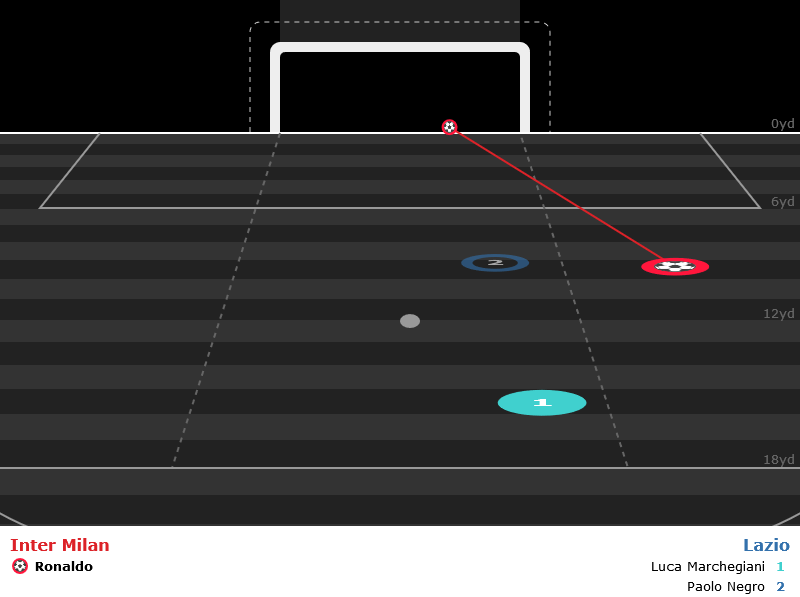Throughout the 1990s, the UEFA Cup was a favourite hunting ground of Italian teams, who took home 8 out of 11 trophies, and accumulated 14 total appearances in the final of the competition.
The 1998 UEFA Cup final between Inter and Lazio was the fourth - and so far the last - occasion in which two Italian teams competed for the trophy, a worthy epilogue to a season that has marked, even in controversy, the history of the two clubs and of all Italian football. At the beginning of that campaign, Massimo Moratti, in his third season as Inter's president, bought Ronaldo from Barcelona for the record sum of 50 billion lire. The previous season, Ronaldo had been Pichici with 34 goals and had scored a total of 47 goals in 49 games (or, if you prefer, 0.91 goals for 90, penalties excluded). The number nine of Moratti's dreams finally signed for a team, which could also count on a young Javiér Zanetti, Youri Djorkaeff and striker Iván Zamorano, among others.
Defender Taribo West, midfielders Diego Simeone and Benoît Cauet and winger Francesco Moriero also became Nerazzurri players that summer too. And finally, Moratti purchased also a 21-year-old Uruguayan fantasista with chubby cheeks and bowl-shaped hair, who made his debut 20 minutes before the final whistle of the first game of the season against Brescia, and overshadowed Ronaldo with two goals from a remarkable distance and bewitched his president with an irrational love. He was El Chino Álvaro Recoba.
For the managerial role, now left vacant by Roy Hodgson, Inter appointed Luigi Simoni, known as Gigi, unemployed after the end of a difficult relationship with Napoli president Corrado Ferlaino. He was a coach who still believed in rigid man marking and the use of the libero.
The Nerazzurri started off with 3 wins in the league and took the lone lead in Serie A, keeping it until match-day 17, when they were overtaken by Juventus, perhaps the strongest team in Europe at the time and not surprisingly a Champions League finalist.
The head-to-head with the Bianconeri continued until the direct clash at the Delle Alpi on April 26th, decided by a goal by Alessandro Del Piero, but, inevitably, also by a controversial body check between Mark Iuliano and Ronaldo, an event that became perhaps the most debated refereeing decision in the history of Italian football.
Moratti and Ronaldo's Scudetto dreams vanished with the final whistle and Inter were left to concentrate on the UEFA Cup, where they had reached the final, after a semifinal with Spartak Moscow, decided by two 2-1 wins and above all by Ronaldo's double in Russia.
The other finalists were Lazio; a team that had thrashed the Nerazzurri 3-0 at the end of February and who had held title aspirations of their own deep into the season before, before a very bad final run of results, which saw the Biancocelesti lose at the Olimpico to Juventus and collect just one point in the last six games, eventually dropping to the 7th place in the standings.
Like Inter, Lazio had strengthened considerably behind the will of their owner Sergio Cragnotti, who had entrusted the team to Swedish coach Sven-Göran Eriksson. The former Sampdoria coach brought number 10 Roberto Mancini from Genoa, while the club snatched Vladimir Jugović and the prodigal son Alen Boksić from Juventus. The midfield was renewed with the arrival of Matías Almeyda, while the defence was bolstered with full-back Giuseppe Pancaro.
Among its ranks, Lazio also included the elegant 21-year-old defender Alessandro Nesta (whom Eriksson called the strongest player he trained at Lazio) and a 24-year-old Pavel Nedved, who was their top-scorer in all competitions--alongside Boksić--with 15 goals.
Though the league challenge was derailed, Eriksson retained the faith of Cragnotti and president Dino Zoff by winning the Coppa Italia against AC Milan, and laid the foundations for Lazio's 1999/2000 Scudetto. Their path to the UEFA Cup final was relatively straightforward and they arrived unbeaten and with just 3 goals conceded and 16 scored throughout the competition, beating Atlético Madrid in the semifinal.
By coincidence the day of the final, 6th May 1998 was also the date on which the club became the first Italian team to be listed on the stock exchange.
The game was held at the Parc des Princes in Paris, and was particularly important as a dress rehearsal of the 1998 World Cup that was just around the corner.
Simoni was forced to do without captain Giuseppe Bergomi and chose Salvatore Fresi for the role of the libero. West, Francesco Colonnese and Zanetti completed the defense in front of Gianluca Pagliuca’s goal. The four midfielders were arranged in a sort of diamond, with Zé Elias as the playmaker, Aron Winter and Simeone on his sides and Djorkaeff as the offensive midfielder. In attack, Ronaldo was paired with Ivan Zamorano.
Eriksson was unable to call upon Boksić (who also missed the World Cup with a knee injury), and replaced him with Pierluigi Casiraghi. Alessandro Grandoni came in for Pancaro at right full-back. With Marchegiani in goal, the first line of the 4-4-2 was formed from right to left by the then Italy Under-21 right back, Nesta, Paolo Negro and Giuseppe Favalli. Giorgio Venturin and Jugović were the two central midfielders, with captain Diego Fuser wide on the right and Nedved on the left wing. Mancini acted as second striker behind Casiraghi.
The deadlock was quickly broken. Simeone, left without pressure by Lazio, delivered a long ball behind the defense to Zamorano for the first goal of the game. The mistake of Erikisson’s defense was quite clear, as defenders were neither positioned to set an offside trap, nor were they running backwards as would have been advised by the situation.
Both Inter and Lazio were two teams that were at their best when on the counter and after the 1-0 Simoni was very happy to leave the ball possession (63% to 37%) to his opponents. From the very beginning, however, the difference between the two coaches' defensive approach was also emblematic. Simoni's system of play was still strongly influenced by the mixed zone: in addition to the use of the libero, the man-marking applied by his team was rigid, so much so that the formation of Inter in the defensive phase was determined exclusively by the positions of the opposing players.
Without the ball, Fresi positioned himself behind the defensive line, with West marking Casiraghi and Colonnese with Mancini. Zanetti engaged a personal duel with Fuser right from the start, both defensively and offensively, while Nedved was marked by Winter, leaving Simeone and Zé Elias in numerical parity with Lazio's midfielders. Even in the defensive phase, Inter's formation was peculiar: Winter - who perhaps could have been a fullback today - offered a wide pass line, while Djorkaeff dropped on the right halfspace to balance their occupation of the field.
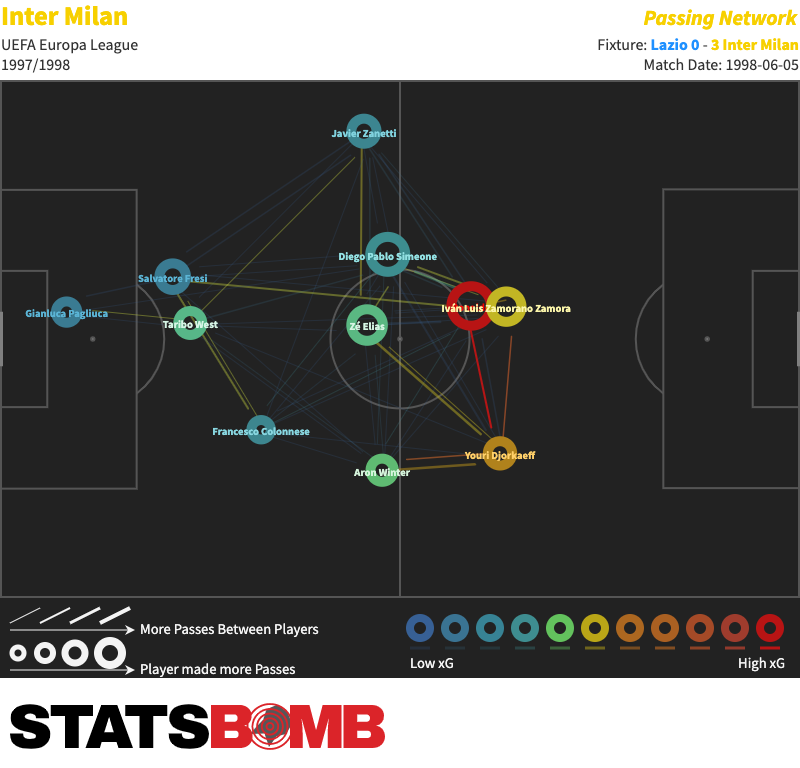
Eriksson, on the other hand, used a 4-4-2 with a zone defense, using a medium-low block in the defensive phase and without exerting particularly aggressive pressure on the opponent's ball carrier. There were moments in which Lazio compacted the two lines of 4 to reduce the space available on the side of the ball, but also those in which the Swedish coach decided to raise the pressing. In these situations, one attacker pressed the opponent's defender in possession and the other marked the closest pass option, while the midfield prepared to block passing lanes, with the aim of forcing a risky pass or a long ball.
During the offensive phase, Lazio used to rely heavily on its center forward, in this case Casiraghi, but Inter was also repeatedly looking for Zamorano. Reviewing the amount of long passes towards the two teams’ target men makes a certain effect and gives a clear idea of how much having a striker good in the air was important for almost all the coaches of the time, as well as how much football has changed since then.
Both Zamorano and Casiraghi probably had good strength in their aerial game and a trademark move in the header. However, the confrontation between the two was clearly in favor of the Chilean, who won 6 out of 10 aerial duels and assisted Zanetti’s goal with an headed pass, while Casiraghi came out as the winner only 3 times (33%), limited by West’s dominance on high balls (7 aerial duels won, 78% of the total).
If Casiraghi acted as the offensive focal point, Mancini would roam across the attacking front, looking for the combination with Fuser or Nedved, or alternatively to create dangers through dribbling or a first touch pass towards a running teammate. Even at 34 years of age, Mancini was still a useful player, but although he was second only to Nesta for touches in the game, during the match he was often neutralized by an excellent marking by Colonnese, whose performance was one of the keys to Inter's victory.
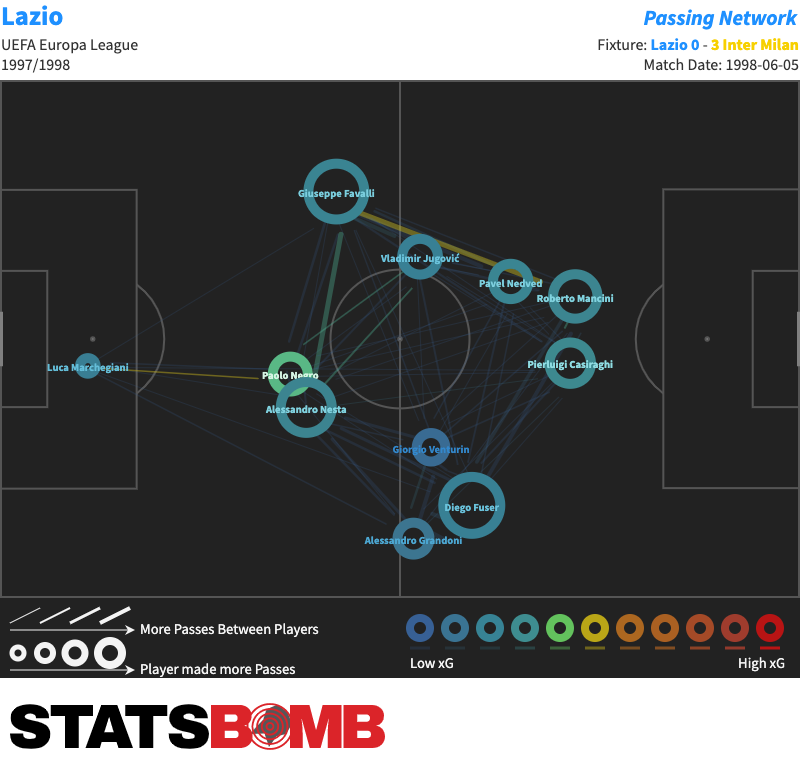
Although they had to overturn the result and thus control game with the ball, Lazio was a team built to play vertically. Nesta (134 touches) and Negro (92), rather than Venturin, were the players who controlled the rhythm of the game starting from the defense, deciding whether to accelerate with a play towards the strikers or to distribute the ball along the flanks. On the right side most of the responsibility for the progression of the game depended on Fuser, the Lazio player with the most dribbles (4) and passes in the last third (23), an throughout he did ran the inside channel, waiting for the overlap of Grandoni.
During the 2nd half the right back was also replaced by Eriksson with the more offensive Gottardi, perhaps to try to get to the touchline and cross with more consistency, as Fuser's movements on the inside attracted his marker Zanetti and left the left side of Inter's defense unprotected, where Fresi had to be the one to leave position intervene. On a couple of occasions Grandoni even had the time to receive the ball behind the defense, forcing the libero to save the situation with a desperate tackle. Nedved started wide on the left, but gradually moved inside the field, in part because of Winter's marking in the defensive phase, which saw him practically acting as the right wing back. Across the field, Jugović made similar movements.
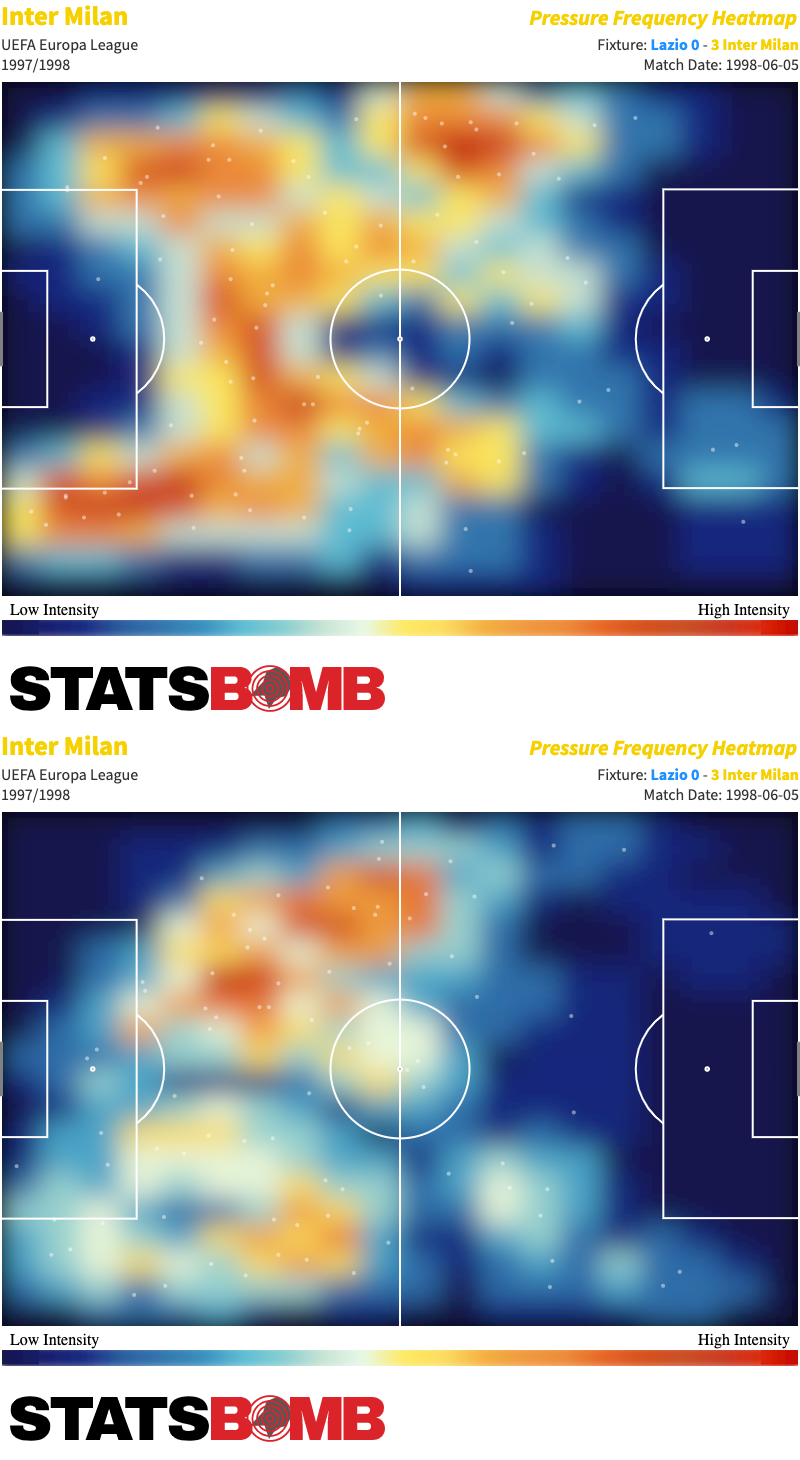
Inter’s pressure heatmap in the 1st half (top) and the 2nd half (bottom)
Lazio came close to a draw in the first half, but Inter's defensive scheme, which bargained almost entirely on their superiority in individual duels, proved to be decidedly solid and more reliable than Eriksson's zone defense. Zamorano found another chance shortly after the start of the second half having beatne the offside trap, but it was a rare goal by Zanetti, perhaps the most beautiful and important of his career (alongside one in 2007/2008 against Roma) to double the Nerazzurri’s lead: a volley with the ball bouncing in his direction, which ended its trajectory on the top corner of the goal.
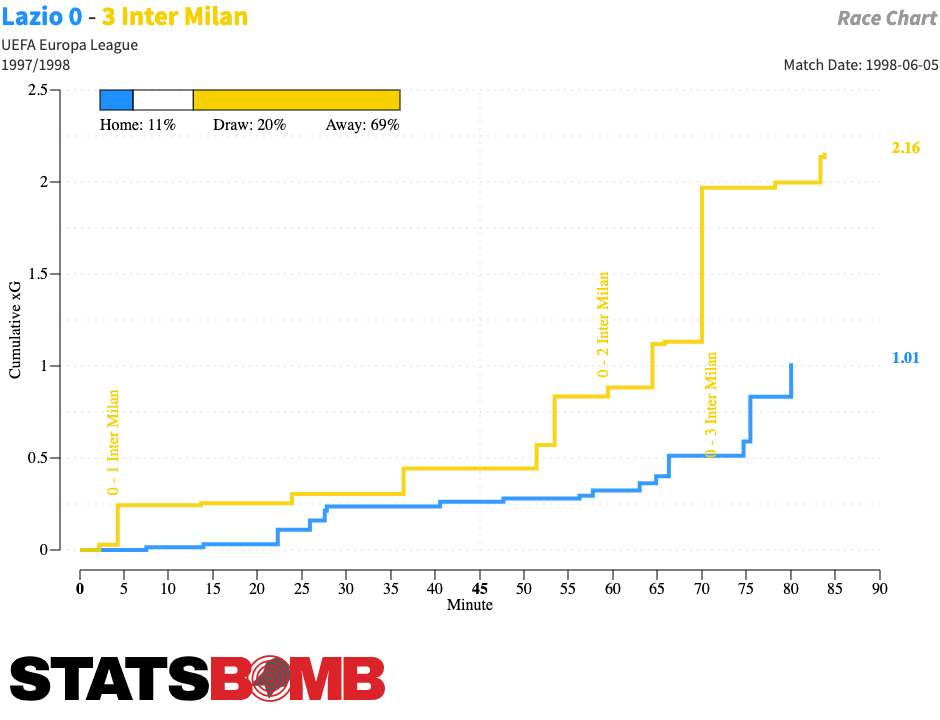
By now, the UEFA Cup was virtually on its way to Milan. All that was missing at that point was the Fenomeno’s signature on the trophy. And Ronaldo’s goal naturally arrived, when in the 70th minute he was served by Moriero, beat a close offside decision and scored to make it 3-0. An iconic run that ended with him dribbling past even Marchegiani.
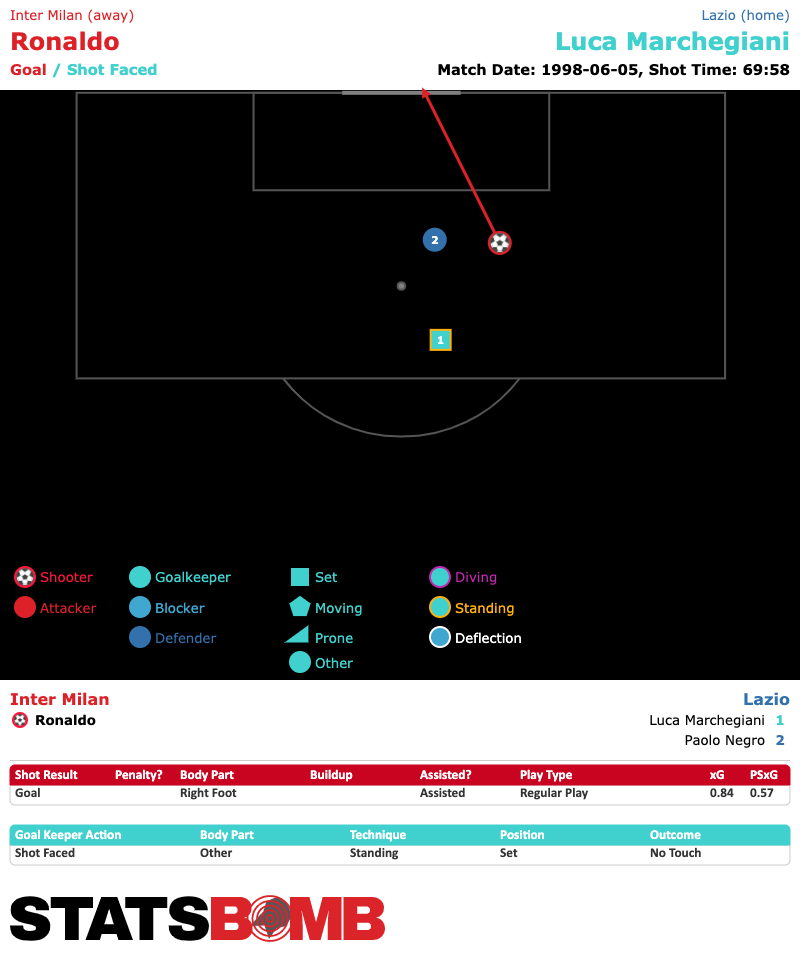
The 90 minutes in Paris are illustrative of how Ronaldo was a unicorn before unicorns, a complete forward with a pioneering quickness that made him literally unplayable even in Italy, where the attention to the defensive phase – and it’s not a cliché - was much more accentuated than in the Eredivisie or La Liga. In 1998 Ronaldo was the future of football and his talents were timeless, he would be similarly feted today. We remember him as one of the best number nines of all time, but on that occasion, wearing the number 10, he played as a second striker, supporting Zamorano and helped the team in all areas of the pitch, despite having a talent several orders of magnitude greater than any of his teammates. The amazing aspect of this performance, which perhaps wasn't even the best in the competition compared to the semi-final against Spartak, was the magnetism he emitted.
Ronaldo eluded Gottardi twice and on the second occasion he sat him down with an “elastico” in one of the 5 dribbles completed in the final.
Ronaldo was Inter's mainstay in that match, being not by chance the player with the most touches or the most decisive player in chance creation. With only 3 shots, he accumulated 0.91 xG but if we examine his overall involvement with xG chain (xGc), a metric that measures the xG of all the actions in open play in which a player is involved, the figure rises even to 1.71 xGc (out of 2.16 xG overall).
If the 0.91 xG shows his ability to be in the right place at the right time, the remaining part of the metric is an indirect measure of the gravitational attraction that Ronaldo exerted on his opponents. The Brazilian was the "Phenomenon" but also the great facilitator of Simoni's Inter, able to generate superiority and consequently to open spaces and to create opportunities for his companions either directly or otherwise. This was an unique feature, which can only lead to an immediate comparison with Lionel Messi, perhaps the only other player able to attract opponents as if he were a celestial body.
We could dismiss the Paris final as the last triumph of an obsolete and reactionary football, almost a revamp of the mixed zone, on pure zonal defense and Eriksson's modern 4-4-2. But it would be a superficial assessment that would overlook how Simoni's Inter system, regardless of its ideological roots, was built to maximize Ronaldo's futuristic talent, without leading to tactical imbalances or bad moods in the locker room. A concept that transcends footballing eras and remains very relevant even in the age of "super teams" and "unicorns". And that explains how the gentleman coach of Crevalcore has remained one of the most beloved managers in the history of Inter, also for his undoubted bond with Ronaldo. That evening, in addition to the UEFA Cup, the Brazilian also won the bet to cut his coach's hair, shaving him with an electric razor.
